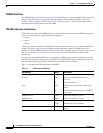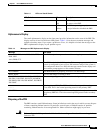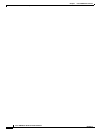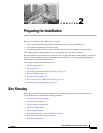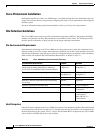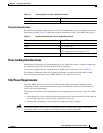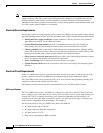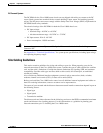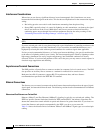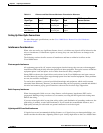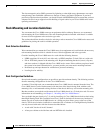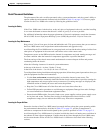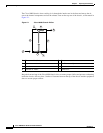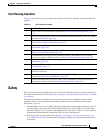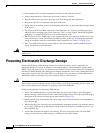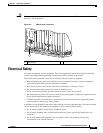
2-6
Cisco 10008 Router Hardware Installation Guide
OL-0659-13
Chapter 2 Preparing for Installation
Site Planning
Interference Considerations
When wires are run for any significant distance in an electromagnetic field, interference can occur
between the field and the signals on the wires. This fact has two implications for the construction of plant
wiring:
• Bad wiring practice can result in radio interference emanating from the plant wiring.
• Strong EMI, especially when it is caused by lightning or radio transmitters, can destroy the signal
drivers and receivers in the Cisco 10008 router, and can even create an electrical hazard by
conducting power surges through lines and into equipment. (Review the safety warnings in the
“Preventing Electrostatic Discharge Damage” section on page 2-12.)
Note To predict and remedy strong EMI, you may also need to consult experts in radio frequency interference
(RFI).
If you use twisted-pair cable in your plant wiring with a good distribution of grounding conductors, the
plant wiring is unlikely to emit radio interference. If you exceed the recommended distances, use a
high-quality twisted-pair cable with one ground conductor for each data signal when applicable.
If wires exceed recommended distances, or if wires pass between buildings, give special consideration
to the effect of a lightning strike in your vicinity. The electromagnetic pulse caused by lightning or other
high-energy phenomena can easily couple enough energy into unshielded conductors to destroy
electronic devices. If you have had problems of this sort in the past, you may want to consult experts in
electrical surge suppression and shielding.
Asynchronous Terminal Connections
The PRE provides a Console Port to connect a terminal or computer for local console access. The PRE
also provides an Auxiliary Port to connect to a modem for remote dial-in console access.
Both ports have RJ-45 connectors, support RS-232 asynchronous data, and have distance
recommendations specified in the IEEE RS-232 standard.
Ethernet Connections
The distance you can extend your networks or the distances between them depends on the type of signal,
signal speed, and transmission media used. The following sections detail recommendations for Ethernet
connections.
Ethernet and Fast Ethernet over Twisted-Pair
Ethernet (10BaseT) and Fast Ethernet (100BaseT) signaling is typically over twisted-pair cabling. The
IEEE has specific distance limitations detailed in IEEE standard 802.3, but industry experience has
shown that connections remain reliable at speeds and distances far greater than these. If you choose to
exceed the distances and speeds recommended by the IEEE, you do so at your own risk.
Table 2-4 shows the distance limits for Ethernet 10BaseT and 100BaseT signal types over twisted-pair
cabling.



